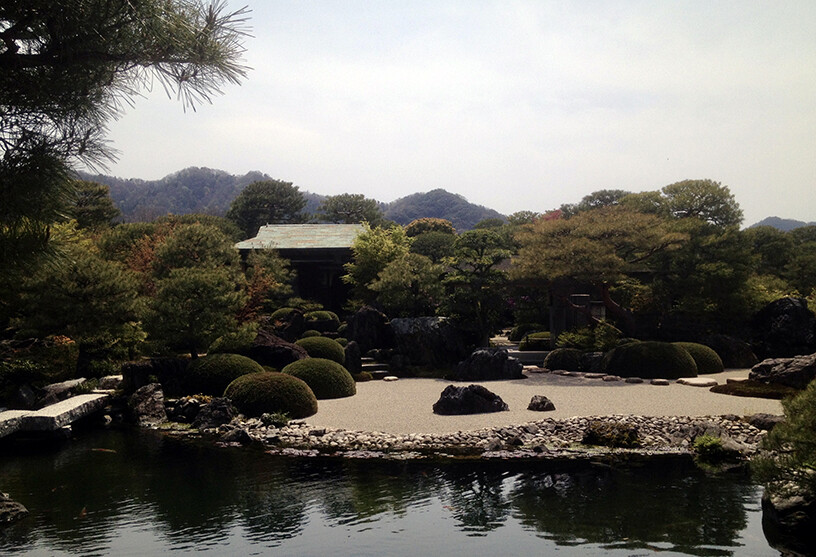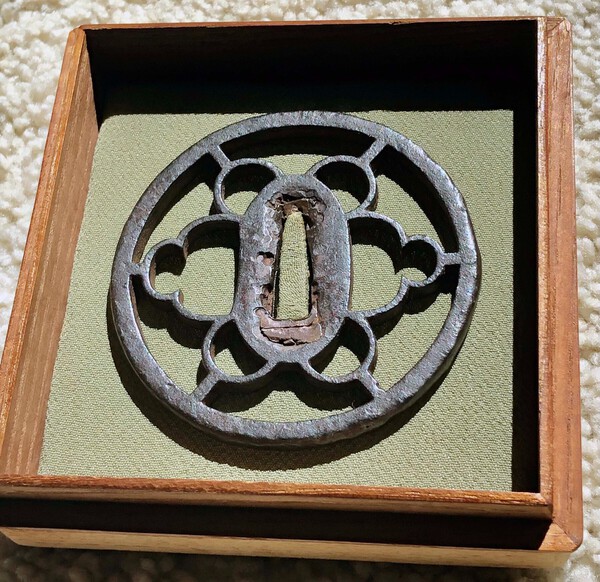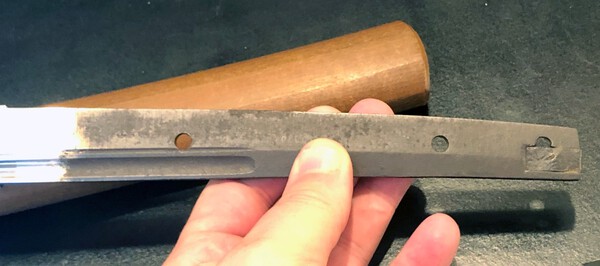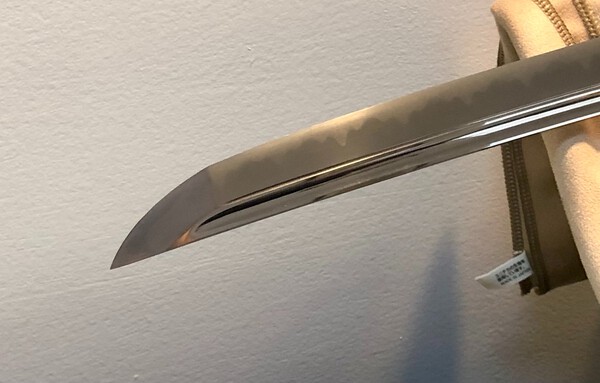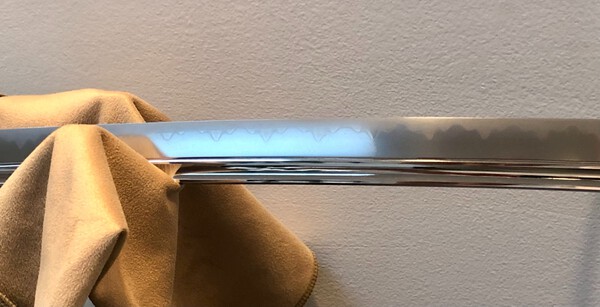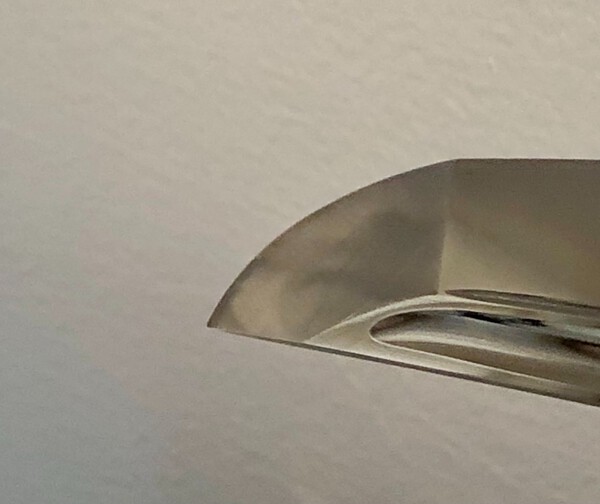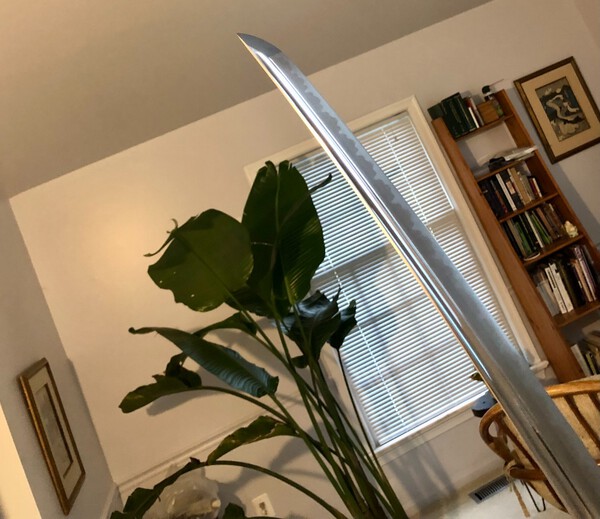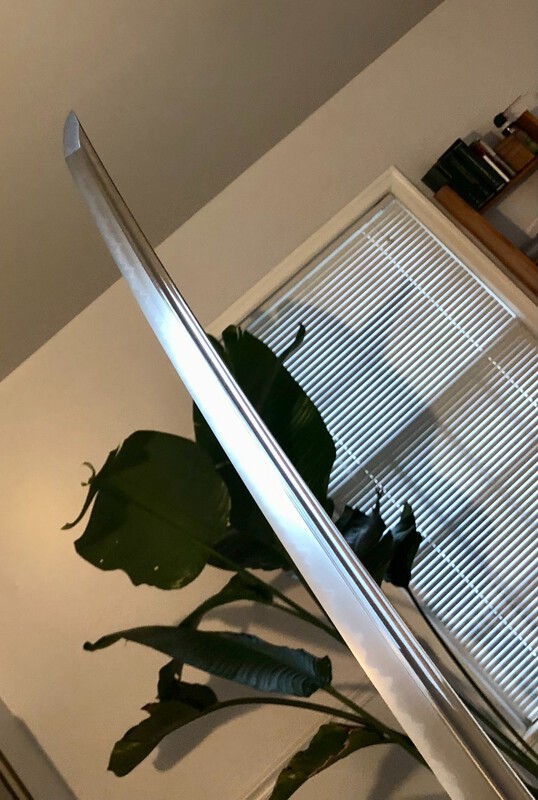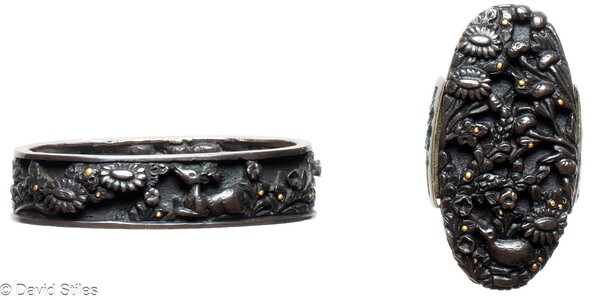-
Posts
2,901 -
Joined
-
Last visited
-
Days Won
3
Content Type
Profiles
Forums
Events
Store
Downloads
Gallery
Everything posted by Soshin
-
Nice tsuba thanks for sharing. I have a nice tsuba with similar large size, plate metal distribution (niku-oki 肉置), and style of craving (maru-bori 丸彫) without the brass inlay or the soft metal rim cover at NBTHK shinsa this year. I think it will be attributed to Kamakura (鎌倉). Not completely sure about your tsuba, but I think it would also get the Kamakura attribution if submitted to the NBTHK. The inlay and soft metal rim cover was all likely added later.
-
It was a nice tanto with an unusual shape. Thanks for sharing.
-
I completely agree, it is a good point to keep in mind as a collector. The same thing can alos be said about the Shoami School as well. The techniques used were so numerous across all the many different regional Shoami schools. When you just examine signed examples, you see an extremely broad range of techniques unitized.
-
While the subject and design are the same, I am seeing a substantial number of differences in the exception of the design between the two tsuba. The first being the use of a fair about of openwork in the negative space, but also the details of fins, horns, and scales.
-
Hello Colin H., Nice tsuba and in answer to the above questions I think your tsuba looks to be the work of the Ito School of Musashi Province (around Edo) circa the late Edo Period early to mid-19th Century.
-
Hi Florian, I was thinking that originally as well in my original writeup after recovering it from my archive last weekend. The Suhama theme mentioned by @ROKUJURO is interrelated to mochi. I was thinking of mochi or suhama during New Years. I did come across this entry in Wikipedia about Kagami mochi (鏡餅, "mirror rice cake") as a traditional Japanese New Year's decoration. Kagami mochi - Wikipedia
-
While temple bell or Bonshō (梵鐘) theme is a common theme on Kanayama tsuba with my specific example I don't think that is the theme. The stylized profile of a temple bell is different than what ia seen on the left and right sides of my tsuba. Below is a photo of a temple bell example from Wikipedia. It is the large bell at Ryōan-ji a Buddhist temple in Kyoto and a photo of my tsuba for comparison purposes.
-
Hi Daniel, The overall finish to the forged iron plate which is casued by an extra heat treatment plate is called (yakite shitate 焼手仕立). I would agree the design is remarkably like my tsuba. Thank you for posting a photo. I was thinking the design of my tsuba and your posted tsuba is that of stacked rice cakes (mochi 餅) in stylized profile. Thanks, NMB this topic allowed me to better focus my write-up about this wonderful tsuba.
-
It has been months paying for this tsuba and now I finally have it completely paid off. Here is a view of the Kanayama tsuba made circa the late Muromachi to Momoyama Period in the noonday sun through my skylights in my study. It measures 7.7 cm round and is 5.4 mm thick at the rim and thins toward the center. It was previously in my collection, and I was able to photograph it in detail. More photos and information will be up on the homepage of my website (Tsuba Otaku | Reflections of a Not So Empty Mind) the first of April. Feel free to discuss it politely and let me know if you have any questions.
-

daimyou54eb. Unpleasant surprise.
Soshin replied to Tensho's topic in Auctions and Online Sales or Sellers
I have purchased more than a few swords and sword fittings from them over the years without any problem from eBay and directly. They are a high-volume lower quality dealer. As I mature as a collector, I have purchased less and less from them, naturally selling many things from them out of my collection with my own business. Buying less had nothing to do with their service, which was always great to me, just my natural progression as a collector. -
Hi Ron, Thanks for sharing a few photos of your new sword. I only had one Japanese sword with a hamon like that through the years. It was a tanto attributed to Uda Kunimune by the NTHK. It was made circa the Tenbun (天⽂) era of the Late Muromachi Period. I have the hamon as (ko-suguha 小直刃) another term for itosuguha. Here are a few photos I was able to dig up from my archive. Unfortunately, I cannot really offer any additional information about your sword or its maker Hidetoki.
-
I agree with @Ray Singer statements above. My only katana is a koto with an orikaeshi-mei of Kanemoto (兼元) done after the sword was shortened. In my case the original signature was just two Kanji characters. Your sword also likely only had a two-character signature before the sword was shortened.
-
Need to explain my downvote. I was only expressing my dislike of the linked example. I have respect for Hirata Hikozo and this body of work. I liked many of the tsuba that started off this tread but above example I not a fan off. The openwork design looks more than a bit plain and awkward to me. I would also expect a deeper patina and more use of black lacquer on a plate of refined copper.
-
Hi Dale, Thank you for sharing the postcards with the tsuba pictures. That is a forging flaw in the iron. I have a Ko-Kachushi tsuba with one of them near its ji-sukashi and once own two Owari tsuba (one with a NBTHK Hozon paper) with them as well. They were common in old iron tsuba and are often not "fatal" so to speak and do not affect function. Yes, Umetada Myoju was a master. That is just one of his low Hozon level work examples. I once saw I Nobuie with only a Hozon level NBTHK paper and was told the same thing at a club meeting in New York. LOL
-
These pieces never really interested me as a collector, and I have seen many throughout the years in many different collections. I do suggest you study and read more make your collection your own through your own efforts with help from a study group or club to learn more about and study fine examples of Japanese sword fittings. Posting well-reasoned and insightful questions NMB is also helpful. Having some know knowledge of Japanese, art, culture, and history will also help you build better understanding of greater context to what you learn about Japanese sword fittings. Having some field trips in Japan is also incredibly fun.
-
Thanks Brian, I'm not sure about the results of the NBTHK shinsa next year but we will see. I am sure I will learn something by submitting it. Just to refresh everyone's memory this long sword (~73 cm nagasa) has a shorted tang (suriage 磨上). The Kanemoto niji mei is also turned-black (orikaeshi-mei 折返し銘). Here is a photo from an ealier post about my katana.
-
Yes, I am incredibly happy with how the polishing turned out. Sometime later on a sunny day I will take better photos with my camera and not my iPhone.
-
I received the Kanemoto Katana today. While the outside lighting on this chilly rainy day was not the best the katana still looked great after getting it unpacked and the Saran Wrap taken off the blade from shipping. (This is a bit harder than the tanto I had polished in the past.) Here are some photos after I cleaned the oil from the blade. The sanbonsugi (三本杉) style hamon made up of a very refined nioi (匂) is extraordinarily strong with this sword. The mune and bo-hi of the sword are now exceptionally clean and completely rust and stain free. I will be submitting this sword to NBTHK shinsa next year.
-
Just a restorative cleaning of set mostly focused on the kashira. The patina is nice and complex on this set making it a change to light for photograph. I might go back to editing the above after image in Photoshop. Just to be clear, nothing was done to the patina of the set.
-
Thanks Dan. I have long considered the restoration of this set from early 2021 all the way through 2022. It was not an easy decision. I would disagree, but I can understand it and expressing your opinion in a respectful manner is important. The set and more specifically the kashira I think in the long term will benefit from the removal of what I think was dried dirt mixed with pine pitch or something similar. The set is hard to photograph, and I couldn't get the lighting as good as the original photograph even with the same camera. Here is a photograph of the set under different lighting after restoration. @Franco D You are very welcome. You might already be aware of him. I will send you a PM once I contact the restorer and get his permission to share his name.
-
Here is a before and after picture of a Katana sized Ko-Mino Fuchi-gashira (古美濃縁頭) set that underwent professional restorative cleaning. Most of the arduous work was done on the kashira. The set turned out very well in my opinion. The set is hard to photograph in detail because the height difference between the base and the top of the carving is very great. This is a characteristic of the workmanship of the Ko-Mino group. By the Edo Period the difference between the base and the top of the carving was reduced. I am going to upload a full set of high-resolution photographs to my homepage (https://www.tsubaotaku.com/) on the first of March but wanted to show two photographs at lower resolution as a fun preview on NMB. Let me know if you have any questions and feel free to discuss it openly but in a polite and respectful manner. Before: After:
-
Funny thing is I completely ignored the "estimated value" statement on the paperwork before liking it. I would agree with Brian's statement above. Since April you are in the USA contacting @Ray Singer, @Mark, or @Grey Doffin would be a clever idea to obtain a few current value estimates of the Japanese sword in the USA Japanese sword market.
-
I heard back from Woody Hall today. He has been working on my blade since last week and he thinks he should be done in a couple of days. He is going to let me know when he is finished and the blade really to ship. I will keep everyone updated.
-
Hello Colin, I once had a menuki set with the same bamboo and crab design. I would agree with Curran's call of it being the work of the Aizu Shoami School. In terms of age of would say early Meiji Period to late Edo Period circa early to mid-19th Century. It is hard to be much more specific given your tsuba isn't signed. Check out my link below my personal collection website. I have been collecting for a while now had have amassed a sizable collection myself not to mention all the tsuba I sold directly and indirectly when I had my Japanese art and antiques business.

